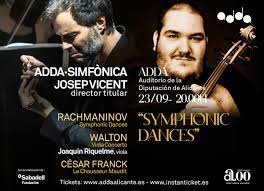“Less is more” is an expression that I have often heard when I have proffered criticisms of the music of Wolfgang Amadeus Mozart. Usually these words follow a criticism of mine where I use Mozart as an example of the predictability of the machinations of Classicism when contrasted with the fluidity and personal expression of nineteenth century Romanticism, or indeed the wholly personal world of twentieth century music. I have not usually given the Classical era a great deal of credibility, generally finding its products elegant, but rather repetitive and lacking in intellectual challenge. After an evening with Fumiaki Miura in ADDA, Alicante, I now understand the term “less is more” somewhat better.
Fumiaki Miura, without doubt, is one of the premiere rank of soloists currently populating the world’s concert halls. And it is rare, amongst this group of international superstars, to encounter a musical personality like that of a Fumiaki Miura, a talent that displays understatement, apparent humility and much reflection.
Fumiaki Miura’s program with the ADDA orchestra looked conventional. He opened with Mozart’s Marriage of Figaro Overture and then played Mendelssohn’s famous violin concerto. More Mozart opened the second half, but this was the less than familiar Little Night Serenade, K525. A stirring but entirely controlled performance of Mendelssohn’s Italian Symphony finished the evening. But the originality in this program came from Fumiaki Miura’s role.
It has become commonplace in recent years for a soloist also to conduct. And on this evening that is what happened. Fumiaki Meera conducted the overture and the symphony, whilst he was both soloist and conductor in the concerto. The difference, and it was a crucial difference, came in the Mozart Little Night Serenade the start of the second half.
In K525 Mozart wrote a dialogue between two orchestras. It is neither a grand work not a serious dialogue, but it remains a small orchestra effectively being a soloist in front of a larger band. So here Miura Fumiaki was leading a small group of soloists, playing himself and directing at the same time. This was wholly original. And the piece itself worked beautifully, as did the director’s choice of treating all the small orchestra as soloists of equal stature. Hence my observation of humility.
And so, on an evening where nothing on the printed programme naturally appealed or excited this particular audience member, Fumiaki Miura’s performance and direction became the memorable aspect of a memorable concert. It must also be said that Fumiaki Miura’s own playing of the Mendelssohn concerto was rapturously received by the audience and the orchestra alike. His tone high up in the violin’s range is both sweet and accurate, with none of the occasional metallic timbre that can sometimes intrude in that upper register. His playing was also undemonstrative, displayed none of the pyrotechnics that are often associated with big name performers. This was music in its purest, wholly communicative form.
As an encore, the orchestra offered a short piece of
Mendelssohn, more like chamber music for orchestra than a rousing lollipop to
end an evening. This too worked beautifully, and an understated but thoroughly
virtuosic evening of Classicism and early Romanticism delivered surprises
throughout, as well as beautiful music. For this concert goer, this less was
surely more.
.jpeg)




.jpg)


.jpg)










